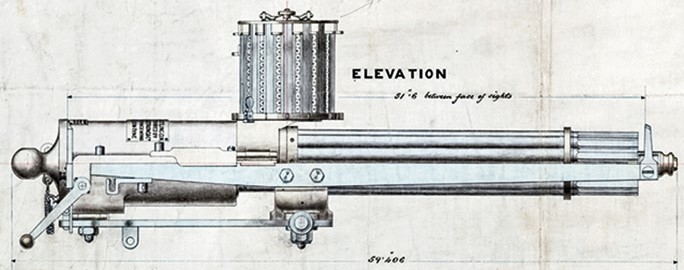91
Gunsmithing/Kit builds / Re: Gatling gun build
« Last post by JonesL on June 30, 2021, 11:29:30 AM »You're right. Once the etching makes it past the mask, it will continue sideways in addition to down. Most of my electro-etching is lettering down into the background and there you can get a pretty deep etch.
For raised lettering, you have to watch the process closer and my guide is when I start to see the mask start to lift on the finer detail, I stop.
>>With any metal working or etching process; practice on some scrap first to get a feel for the job.<<
For extra fine detail I use this outfit http://www.img-electromark.com/ I send them my artwork and they convert it to a stencil, basically a very fine mesh silk screen. I tape the stencil down and when my electrical current is applied the electron flow is only through the open mesh. For this fine line etching, I set my battery charger on 2 amp trickle and have even used a Q-tip alligator clamped to the negative lead and the tip dipped into the electrolyte. Pictures are of that process and the results.
Last two are of chemical etching.
https://ibb.co/XjPJxcv
https://ibb.co/j5d7Yzv
https://ibb.co/gdnpnnH
https://ibb.co/3fMRfRm
https://ibb.co/nQbWV5g
https://ibb.co/LPX5jwm
Another process, this time chemical etching on brass, is to use ferric chloride (used to make printed circuit boards). Read up on ferric chloride before you start as it has some odd properties; "Ferric chloride is not an acid but acts like one in the presence of water" which means that the diluted solution is more active than the concentrate.
Be very careful of spills because even if you wipe it up immediately, it'll leave a mark on any brass it touches. Get a drop or two on your skin and you'll end up with a yellowish stain that's as permanent as a USDA beef tattoo.
A silk screen shop screen prints my artwork on brass sheet (make sure any lacquer or wax coating is completely removed down to bare brass first) and the ferric chloride goes after the copper in the brass alloy. This is a very slow process but gives super fine detail. Coat the back of the sheet with a mask of your choice or the plate will be thinner than when you started.
Again, when I start to see the mask lifting, I stop and rinse off the surface with a baking soda and water mix and a scrub brush to neutralize the solution. Dip in acetone to remove the screen print and you're done. Ferric chloride can be used over and over so i just pour off the solution into a container for the next job. Hazmat rules apply with ferric chloride.
With the electro-etching process, you're only dealing with salt water electrolyte and that can be poured down the drain or on weeds you want to get rid of.
For raised lettering, you have to watch the process closer and my guide is when I start to see the mask start to lift on the finer detail, I stop.
>>With any metal working or etching process; practice on some scrap first to get a feel for the job.<<
For extra fine detail I use this outfit http://www.img-electromark.com/ I send them my artwork and they convert it to a stencil, basically a very fine mesh silk screen. I tape the stencil down and when my electrical current is applied the electron flow is only through the open mesh. For this fine line etching, I set my battery charger on 2 amp trickle and have even used a Q-tip alligator clamped to the negative lead and the tip dipped into the electrolyte. Pictures are of that process and the results.
Last two are of chemical etching.
https://ibb.co/XjPJxcv
https://ibb.co/j5d7Yzv
https://ibb.co/gdnpnnH
https://ibb.co/3fMRfRm
https://ibb.co/nQbWV5g
https://ibb.co/LPX5jwm
Another process, this time chemical etching on brass, is to use ferric chloride (used to make printed circuit boards). Read up on ferric chloride before you start as it has some odd properties; "Ferric chloride is not an acid but acts like one in the presence of water" which means that the diluted solution is more active than the concentrate.
Be very careful of spills because even if you wipe it up immediately, it'll leave a mark on any brass it touches. Get a drop or two on your skin and you'll end up with a yellowish stain that's as permanent as a USDA beef tattoo.
A silk screen shop screen prints my artwork on brass sheet (make sure any lacquer or wax coating is completely removed down to bare brass first) and the ferric chloride goes after the copper in the brass alloy. This is a very slow process but gives super fine detail. Coat the back of the sheet with a mask of your choice or the plate will be thinner than when you started.
Again, when I start to see the mask lifting, I stop and rinse off the surface with a baking soda and water mix and a scrub brush to neutralize the solution. Dip in acetone to remove the screen print and you're done. Ferric chloride can be used over and over so i just pour off the solution into a container for the next job. Hazmat rules apply with ferric chloride.
With the electro-etching process, you're only dealing with salt water electrolyte and that can be poured down the drain or on weeds you want to get rid of.


 Recent Posts
Recent Posts